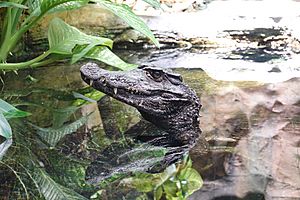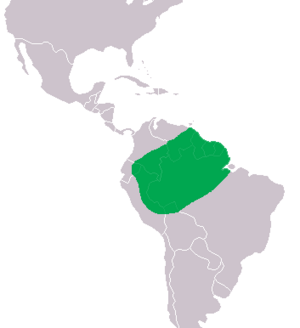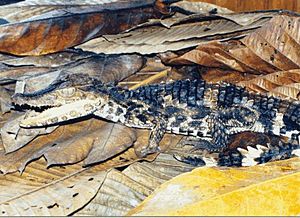Smooth-fronted caiman facts for kids
The smooth-fronted caiman (Paleosuchus trigonatus), also known as Schneider's dwarf caiman, is a type of crocodilian. It lives in South America, mainly in the Amazon and Orinoco Basins.
This caiman is the second-smallest species in the Alligatoridae family. The smallest is Cuvier's dwarf caiman, which also lives in tropical South America. An adult smooth-fronted caiman usually grows to about 1.2 to 1.6 meters (4 to 5 feet) long. It weighs between 9 and 20 kilograms (20 to 44 pounds). Very large males can reach up to 2.3 meters (7.5 feet) in length and weigh 36 kilograms (79 pounds).
Quick facts for kids Smooth-fronted caiman |
|
|---|---|
 |
|
| A smooth-fronted caiman at Zoologischer Garten Berlin in Berlin, Germany | |
| Conservation status | |
| Scientific classification | |
| Genus: |
Paleosuchus
|
| Species: |
trigonatus
|
 |
|
| Smooth-fronted caiman distribution (green) | |
| Synonyms | |
|
|
Contents
What's in a Name?
The smooth-fronted caiman was first described in 1801. This was done by Johann Gottlob Schneider, a German expert in old languages and nature.
The name Paleosuchus comes from two Greek words. Palaios means "ancient," and soukhos means "crocodile." This name suggests that this caiman comes from a very old group of crocodiles. Scientists believe they separated from other caimans about 30 million years ago.
The second part of its name, trigonatus, also comes from Greek and Latin. Trigonos means "three-cornered." The Latin atus means "provided with." This refers to the unique triangular shape of its head.
Appearance and Features
The smooth-fronted caiman's head looks a bit like the spectacled caiman's. However, it does not have a bony ridge or "spectacle" between its eyes.
Its body is covered in tough armor. The scales on its neck and tail are large, triangular, and sharp. It has strong bony plates on both its back and belly.
The tail is quite short and wide at its base. Unlike most crocodiles, its tail is flattened from top to bottom, not side to side. The bony scales on its tail have parts that stick out sideways. This makes the tail very well armored and not very flexible.
This caiman is a dark greyish-brown color. Its eyes are a mid-brown shade. Males can grow to about 1.7 to 2.3 meters (5.5 to 7.5 feet) long. The longest one ever recorded was 2.6 meters (8.5 feet). Females are smaller, usually not more than 1.4 meters (4.5 feet) long. It is a very strong crocodile for its size. It often holds its head high with its neck pointing upwards.
Where They Live
The smooth-fronted caiman lives in the Amazon and Orinoco Basins in South America. You can find them in countries like Bolivia, Brazil, Colombia, Ecuador, French Guiana, Guyana, Peru, Suriname, and Venezuela.
They prefer small streams in thick forests. Sometimes, the water might not even be deep enough for them to fully hide. They are rarely seen in open areas. They also do not usually sunbathe, even when they are in zoos.
Behavior and Life Cycle
Adult smooth-fronted caimans are very good at hiding. You rarely see them during the day. They often hide in burrows underwater. They might also spend a lot of time up to 100 meters (330 feet) away from water. They hide in thick plants, inside hollow logs, or under fallen trees.
Male caimans protect their own areas. Females have smaller areas where they live. Adult caimans spend time both on land and in water. They mostly eat animals like porcupines, pacas, snakes, birds, and lizards. They do not eat many fish or molluscs.
Baby caimans, called hatchlings, mostly eat insects and other small creatures when they are very young. As they grow bigger, they start eating larger prey. This includes small fish, birds, and reptiles. Many young caimans do not survive. However, adult caimans usually live a long time. Large meat-eating animals like the jaguar sometimes hunt them.
Reproduction
Female caimans are ready to breed when they are about 11 years old. Males are ready around 20 years old. The female builds a large nest from leaves and soil. She usually does this at the end of the dry season. She might also use a nest that was already there.
She lays 10 to 15 eggs and covers them with more nesting material. The decaying plants in the nest create some heat. The nest's good insulation helps keep this heat inside. Nests are often built next to termite mounds. The heat from the termites helps keep the eggs at a steady temperature. For male babies to hatch, the eggs need to stay at about 31 to 32 degrees Celsius (88 to 90 degrees Fahrenheit).
The eggs hatch after about 115 days. The mother caiman stays near the nest, especially at the beginning. She protects the eggs from animals that might try to eat them. Sometimes, roots grow through the nest, and soil from the termite mound can stick the eggs together. Because of this, the parents must help the babies get out of the nest when they hatch.
After the babies hatch, the mother carries them to a safe nursery area. She stays with them for a few weeks. After that, the young caimans go off on their own. The female might not breed again for a year.
Status and Protection
People do not hunt the smooth-fronted caiman very much. This is because its skin has many bony scales. These scales make the skin not very useful for making leather. However, some of these animals are caught in Guyana to be sold as pets.
The biggest dangers to this species are the loss of its forest home. Also, gold mining activities can pollute its environment. Scientists believe there are over one million smooth-fronted caimans still living in the wild. The IUCN (a group that studies nature) says this species is of least concern. This means it is not currently in danger of disappearing. It is also listed on Appendix II of CITES. This listing helps control international trade to prevent too much hunting.
See also
 In Spanish: Caimán postruso para niños
In Spanish: Caimán postruso para niños



